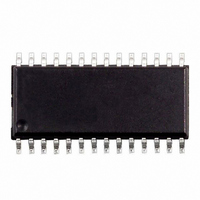E-TDA7400DTR STMicroelectronics, E-TDA7400DTR Datasheet - Page 18

E-TDA7400DTR
Manufacturer Part Number
E-TDA7400DTR
Description
IC PROCESSOR CAR SIGNAL 28SOIC
Manufacturer
STMicroelectronics
Type
Car Signal Processorr
Datasheet
1.E-TDA7400DTR.pdf
(28 pages)
Specifications of E-TDA7400DTR
Applications
Automotive Audio
Mounting Type
Surface Mount
Package / Case
28-SOIC (7.5mm Width)
Lead Free Status / RoHS Status
Lead free / RoHS Compliant
Other names
497-5050-2
Available stocks
Company
Part Number
Manufacturer
Quantity
Price
TDA7400D
supplied by his own biasing circuit.
Trigger Path
The incoming MPX signal is highpass filtered,
amplified and rectified. This second order high-
pass-filter has a corner frequency of 140kHz.
The rectified signal, RECT, is lowpass filtered to
generate a signal called PEAK. Also noise with a
frequency 140kHz increases the PEAK voltage.
The resulting voltage can be adjusted by use of
the noise rectifier discharge current.
The PEAK voltage is fed to a threshold generator,
which adds to the PEAK voltage a DC depend-
ent threshold VTH. Both signals, RECT and
PEAK+VTH are fed to a comparator which trig-
gers a re-triggerable monoflop. The monoflop’s
output activates the sample-and-hold circuits in
the signalpath for selected duration.
Automatic Noise Controlled Threshold Adjust-
ment (ATC)
There are mainly two independent possibilities for
programming the trigger threshold:
a the low threshold in 8 steps (bits D
b the noise adjusted threshold in 4 steps
The low threshold is active in combination with a
good MPX signal without any noise; the PEAK
voltage is less than 1V. The sensitivity in this op-
eration is high.
If the MPX signal is noisy the PEAK voltage in-
creases due to the higher noise, which is also
Figure 17. Block Diagram of the Noiseblanker
18/28
the noiseblanker byte)
(bits D
see fig. 14).
3
and D
MPX
MPX
4
of the noiseblanker byte,
RECTIFIER
D98AU856
CONTROL
LOWPASS
0
to D
2
RECT
of
+
+
+
PEAK
Over Deviation Detector
If the system is tuned to stations with a high de-
viation the noiseblanker can trigger on the higher
frequencies of the modulation. To avoid this
wrong behaviour, which causes noise in the out-
put signal, the noiseblanker offers a deviation de-
pendent threshold adjustment.
-
rectified. With increasing of the PEAK voltage the
trigger threshold increases, too. This particular
gain is programmable in 4 steps (see fig. ...).
AUTOMATIC THRESHOLD CONTROL MECHA-
NISM
Automatic
Stereoblend Voltage
Besides the noise controlled threshold adjust-
ment there is an additional possibility for influenc-
ing the trigger threshold. It is depending on the
stereoblend control.
The point where the MPX signal starts to become
noisy is fixed by the RF part. Therefore also the
starting point of the normal noise-controlled trig-
ger adjustment is fixed (fig. 11). In some cases
the behaviour of the noiseblanker can be im-
proved by increasing the threshold even in a re-
gion of higher fieldstrength. Sometimes a wrong
triggering occures for the MPX signal often shows
distortion in this range which can be avoided
even if using a low threshold.
Because of the overlap of this range and the
range of the stereo/mono transition it can be con-
trolled by stereoblend. This threshold increase is
programmable in 3 steps or switched off with bits
D
VTH
0
and D
1
GENERATOR
THRESHOLD
THRESHOLD
ADDITIONAL
MONOFLOP
of the fieldstrength control byte.
CONTROL
Threshold
HOLDN
Control
by
the













